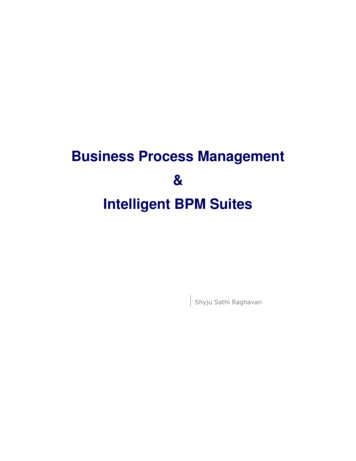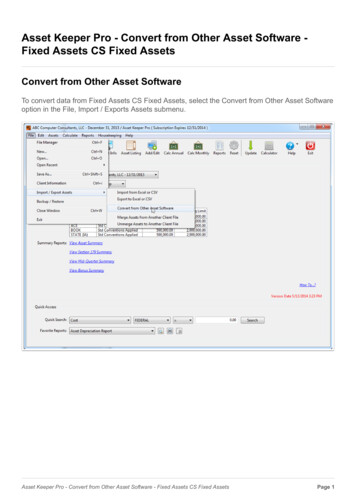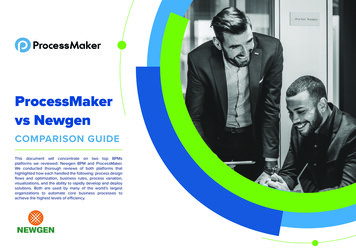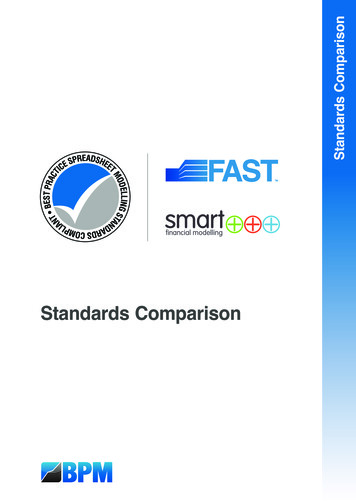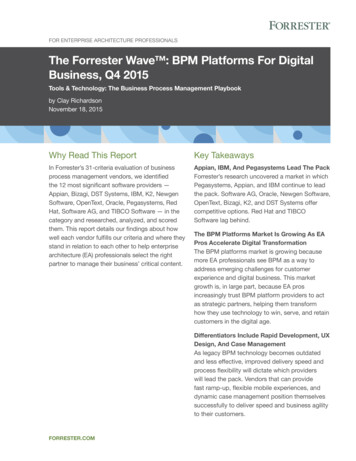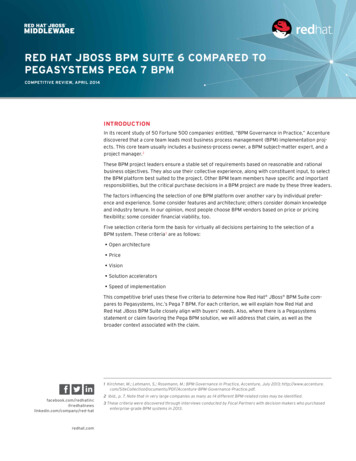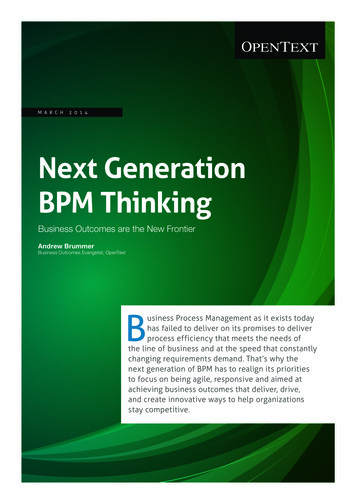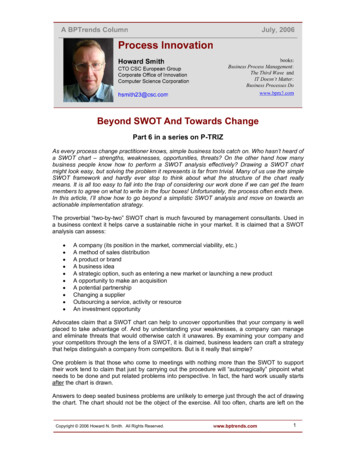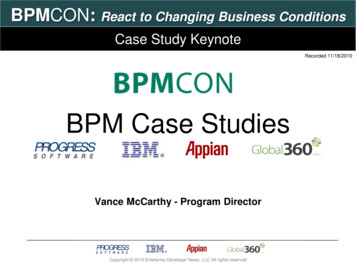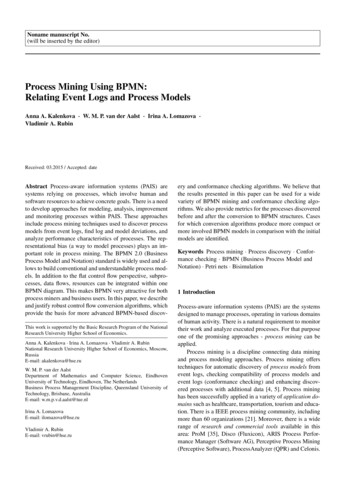
Transcription
Proceedings of the Federated Conference onDOI: 10.15439/2019F110Computer Science and Information Systems pp. 645–649 ISSN 2300-5963 ACSIS, Vol. 18BPM Tools for Asset Managementin Renewable Energy Power PlantsCarchiolo Vincenza , Catalano Giovanni‡ Malgeri Michele† , Pellegrino Carlo† , Platania Giulio† , Trapani Natalia† , Dipartimento† Dipartimentodi Matematica ed Informatica - Universitá di Catania - Catania - Italydi Ingegneria Elettrica Elettronica Informatica - Universitá di Catania - Catania - Italy‡ Development and Support Center - BaxEnergy - Catania, ItalyAbstract—Business Process Management (BPM) is an accepteddiscipline and its importance in increasing automation insideindustrial environment is today recognized by all players. Thecomplexity of modern management process will lead to chaoswithout a well-designed and effective BPM. Several BPM Suiteswere compared and BPM approach was applied to the casestudy of process management in a renewable energy power plant.Results both in process reduction and simplification and flowoptimization obtained in the real case are discussed to stateefficacy and efficiency of the adopted approach.I. I NTRODUCTIONN A competitive environment in which companies haveto provide more and more effective and efficient services/products, asset management allows to obtain value fromassets and achieve the company’s business objective [1]. Toaccomplish both the goals to ensure good operational performance and long durability of the final products/services, it isnecessary to define effective business processes, to monitortheir performances and to provide corrective actions whennecessary. In fact, the quality of the operational processesare more and more dependent on maintenance processes,thus they must be carefully engineered and effectively implemented. Maintenance management changed in the last decadesthanks to ICT development, from a management perspective,Computerized Maintenance Management System (CMMS) hascontributed to enhance the control of maintenance activities [2]and maintenance is considered a relevant business function,able to interact with all other strategic functions, such asoperations, purchasing, suppliers (service providers), warehouses management, administration, therefore maintenanceeffectiveness and efficiency is crucial for business.BPM frameworks provide tools that allow to design thebusiness process using model, maps and rules, than it allowsto implement them defining the architecture and adding rules.Moreover, framework executes and monitors the process (providing processes measurement) collects data, and, finally, itprovides analysis and diagnosis that allows to improve theprocess itself [3].Indeed, the process can be viewed from different perspectives thus producing multiple models and styles [4]: controlflow perspective, resource perspective that means to focuson equipment, units, etc.; data creation perspective; timeperspective that focuses on deadlines and function perspectivethat uses activities.IIEEE Catalog Number: CFP1985N-ART c 2019, PTIBPMN 2.0 is a logical description of business processesand how they operate that focuses on process implementationand Process simulation [5]. Usually, the business processsimulation collects several data and provide a visual animationof the evolution of the process. The analysis of data permitsthe designer together with supervisor and manager to identify(potentially expensive) mistakes and, thanks to the Key Performance Indicators (KPIs), defined during the early designingof the process, increase the performance to getting and overallimprovement of the process (e.g. removing bottlenecks).In literature, the use of the BPM approach for maintenancemanagement is not so common [6] (see references in [7], [8]).Most of them suggest that an Asset Management System Software can help organizations to achieve operational excellence,through a more effective cost control, a more efficient assetplanning, a reducing in capital expenses, an optimization ofoperational costs, thus extending asset life-cycle and obtaininga higher Return On Asset.This works briefly presents some of the criteria that wereadopted by BaxEnergy c to develop a BPMS, starting fromexisting platform aiming at optimizing the maintenance ofrenewable energy power plants to be offered as a serviceto different companies. Renewable-energy Power Plant facesdifferent challenges [9], [10], [11]. Finally, a case study isdiscussed highlighting the enhancement and discussing somedetails that lead to final implementation.Section II introduces BPMS and some of the criteria usedto compare the platforms, and provide the reader with acomparison among several platforms that was available at themoment of the study. Section III discussed the case studydeveloped using the selected platform.II. BPMS C OMMON F EATURES AND C RITERIABPMN can be useful both for planning complex businessprocesses and to control and monitoring them once deployed.A business process can be defined as a set of connectedactivities that create value for customers; usually, they areclassified into three groups: strategic, operational and support.A BPMN provides users and developers with tools that clearlydenote the objective, who is in charge of any operation,starting and ending points, input and outputs, constraintsand monitoring points. One of the most important aspect ofBPMN is surely the graphical model that, usually, is formally645
646documented thanks to UML (Unified Modelling Language)class diagrams [5].BPMN 2.0 is the current standard that adds the followingcharacteristics: human-readability, that is a standard visualnotation for modelling processes; accessibility, that meansthat all actors must understand what is represented; machinereadability, that implies the use of the XML notation forsimulating and executing processes [12].BPMN Graphical representations use several standard symbols that must be easily understood by both developers andusers the most important are: swim lane, pool, box, event,task.A fundamental element to make dynamic the process diagram is gateway: it allow the designer to choose where theflow of a diagram must follow a path or another by evaluatinga condition. Two types are defined in the standard: XOR orExclusive. Gateway is the task that drives the evolution of aprocess by evaluating a condition and selecting the next task,OR or Parallel Gateway split the evolution into two parallelbranches that must be joined with the same element when theevolution of the process does not support parallel activities.A. Evaluation CriteriaThere is no doubt that some interesting features for aSoftware developer are meaningless by the point of view of aBusiness Process developer, and are meaningless for a standardemployee, therefore the evaluation Criteria are grouped intotwo classes. The first group deals with the feature useful tosoftware developers, the most important are as follows: OpenSource, software suite refers to open source model,that means that products are released under an opensource license, this feature allows to inspect the sourceand to add any additional features; Community, the community supporting the software suiteshould be as large as possible to share problems and theirsolutions. A large community implies Documentation andTutorial are easy to find and this is useful both forsoftware and model developers; BPMN 2.0 supported, this is a must for any new software,since today BPMN 2.0 standard is largely supported; Additional modules and connectors, they permits to extend the functionality of the Software and to write newcustom connectors; API provided, this can be useful to easily add functionalities to the BPMS. Innovation, of course, it is important that software solution supports all recent technologies and methodologiesbut it must be also "mature" (according, for instance,with Gartner Magic Quadrant [7]). Some examples ofinnovative features are mobile device deployment withoutthe need to develop a dedicated application, low-codePlatforms, integration with Artificial Intelligence for performance analytics and so on;Second group of features, that we could call Functionalitybased evaluation criteria, belongs to Business Process Developers that focus on the processes themselves and, usually, havePROCEEDINGS OF THE FEDCSIS. LEIPZIG, 2019no specific experience in software development. They needto model, describe and test production processes aiming atoptimizing them according to some metrics (e.g. cost, duration,response time) often conflicting. The most important are listedbelow: Web Modeler/Collaboration enabled, it enables collaboration between developers; Template Library, the presence of a library of reusablemodels is a valuable add-on to any Suite; Model and Process Versioning, since processes run forlong times, the ability to control the current version ofModels and the ability to roll back to a previous versionare very useful; Powerful graphic interface, the interface should supportadvanced interface functions as, for instance, Drag&Dropof models/processes, Form Editing that allows final usersto create and edit data, to customize the colors of elementin a diagram to make it more readable; Process deployment, the system should allows to makean instance of the modelled process to check errors andto locate performance indicators or failures; Testing and Simulation, the presence of an engine forsimulating the process and/or validate the model is anessential feature; Customizable Properties, that means the ability to changethe properties of the trial modelling tool. Business rule engine and activity Monitoring, possibilityto integrate business rules for the process and to monitorthe execution of a process; Integration with Cloud: since some BPMS are integratedwith cloud service, it is important to support the integration between BPMS and Cloud. Role Based Security, that allows to manage of the securityrules for each role.B. A Brief Survey of BPMNs PlatformsThe evaluation criteria used by throughout this work arebased on Critical Capabilities such as Interaction Management,Monitoring and Business Alignment, Rules and Decision Management, Analytic and they are evaluated on the base of someUse Cases. Great importance is given to Continuous ProcessImprovement (referred as CPI) and to Citizen DeveloperApplication Composition (that is the ability to leave aside fromIT development staff) [5].The BPM suites, that was evaluated, support highly intelligent applications which integrate more-advanced decisionautomation technologies (e.g. predictive analytic, artificialintelligence) and decision support for knowledge workersto automate business processes that require an adaptive behaviour [5]. It means that actually iBPMs is not a simplemodelling software or a validation engine for BPMN, but it isboth bound and integrated with other functionalities that keepstrack of statistics and, sometimes, let even the user to defineperformance indicators.The main characteristics of the tools were summarized andcompared in tables I and II, the former deals with features
VINCENZA CARCHIOLO ET AL.: BPM TOOLS FOR ASSET MANAGEMENT IN RENEWABLE ENERGY POWER PLANTSuseful to developers and the latter to features useful to users,i.e. the provided functionalities.TABLE IC RITERIA RELATED TO D YYYY-InnovationYYYYYYYYY-APIYYYYYYY-TABLE IIC RITERIA RELATED TO F tiIBMjBPMKissFlowQuickFlowWeb FunctionsP nitoringYYYYYY(SalesForce)Since the use of opensource platform covering all theprocess, from development to monitoring, exposing a flexibleReST API to integrate easier with existing software are themost important requisites the selected platform was Camunda.The lack of processes Simulation is overcome thanks to the agreat support of Javascript libraries that can be integrated withno effort.III. C ASE STUDYA. The CompanyThe case study was developed, during the research projectWEAMS, in an Austrian company that is a BaxEnergy cclient. The Company’s core business is the construction andoperations management of wind turbine power plants. TheCompany produces electrical energy through wind turbines,by itself or cooperating with other partners or investors. In thecase study was considered that it actually deals with operationsand maintenance processes of wind turbine farms.After studying and analyzing their general organizationalstructure, we find 92 different relevant processes. These processes (e.g., tool provisioning, maintenance execution in harshweather conditions, invoicing, checking financial guarantees,executing training, and so on) include several tasks with theirrelevant costs. In general we identified two main processcategories related to wind turbines maintenance: Core processes (usually technical ones) and Support processes (usuallyorganizational and financial ones).Fig. 1. Collaboration between actors of a processB. Process Re-engineeringA subset of 39 processes out of the 92 relevant for thecompany were selected as they are the most frequently activated during a year and relevant also for other companiesin the same business sector. Moreover, other ten maintenancecore-processes, not previously engineered by the companywere identified and implemented in order to guarantee bettermaintenance performance.A first revision of the processes allowed to increase the general comprehension of process workflows, by the Company. Inparticular, to follow the correct logic of BPMN 2.0: The use of send and receive task was corrected; Some End event were added to complete some workflows; Some Intermediate events instead of useless tasks wereintroduced in order to simplify some process; Some script tasks were modified into normal tasks (because scripts will be added in a future phase); The use of gateway was corrected and useless ones wereeliminated.Furthermore, some specific processes were deleted as standalone processes and they were incorporated within otherones, by producing a unique layout representing the wholeactivity without missing any essential information and bettervisualizing interactions through inputs and outputs.This process synthesis generated a total incorporation of 7process into other ones, thus further reducing to 26 processesout of 39.Let us note, the presence of a particular interaction between pools and collapsed pools inside the processes. Thoseinteractions called swim lanes in the BPMN 2.0 standard areused mostly to enable the collaboration between core andsupporting parts of the processes.For example, in the process Budgeting a supervisor (financing/controlling) of the process needs to receive some additionalinformation before going on with next task. In this case,the supervisor has to do two actions (see Figure 1): Beforethe re-engineering, the company used the above descriptedinteraction also to communications with the ticket system ofWEAMS. Thanks to the BPM system, implemented in theWEAMS system, this use of send/receive tasks is no morenecessary (see Figure 2) but it requires just a simple taskin WEAMS system (see Figure 3). In this way, there is a647
648PROCEEDINGS OF THE FEDCSIS. LEIPZIG, 2019Fig. 2. Collaboration with the ticketing system of WEAMSFig. 3. From ticket system to a simple taskreduction of about 70 message flows due to ticket systemimplemented on the BPM system in WEAMS.These relevant 26 processes were subjected to a deeprevision in order to optimize elements and workflows andsimplfy them. Such a revision allowed to eliminate from theprocesses 26 phases and 106 transitions that was useless,obtaining more efficacy and efficiency in process workflowand improving the general performances of the maintenanceprocesses.In the second step of revision some of the 26 processeswere splitted into two or more sub-processes in order toeasily implement them into the WEAMS BPM system, thusgenerating 31 procesess.In the third step some maintenance processes were addedto manage some aspects that are relevant for the Companybusiness but that never were implemented by the Company,such as Planning ordinary maintenance’s intervention, Humanresources management, Warehouse management with spareparts and consumables, Personnel qualification managementto meet normative requirements, Corrective maintenance management (ticket opening, see Figure 4), Predictive maintenancemanagement (specifically inspections, see Figure 5), Assetstatus management, Service level management, Maintenanceon the field and Logistics management.C. Key Performance IndicatorsThe section in which KPIs have the biggest role is the windturbine maintenance and the most influencing factors are certainly economical, technical and organizational. Maintenanceperformance indicators reflect achievement and progresses inmeeting a goal; clearly, the greater is the installed capacity thehigher are Operational and Maintenance costs.Leading indicators measure performance before the maintenance process results starts to follow a particular trend andmonitor if maintenance activities are producing good resultsin a long-term period. An example Preventive Maintenance(PM) Completion Rate: a low completion rate for PM wouldgenerate an increasing in asset maintenance work while ahigh completion rate means that asset preventive maintenancerequest is correctly being completed and, probably, futurecorrective maintenance requests will be reduced. Anotherexample is the Outage Schedule Compliance an importantmetric to track future maintenance work because it allows tomeasure deferred asset maintenance, resulting in an increasedrisks and likelihood that asset performance will decrease ata future time, leading to lower capacity, increased downtime,and greater expenses.Lagging indicators use historic data to obtain a measure toconfirm coherence with long-term performance trends; theyare used to determine how well a process performs.In order to increase maintenance performance, both internaland external factors of a company should be considered ascomplex activities. Therefore, considering each influencingfactor is essential to assess, control, measure and compareperformances. The KPIs in technical standards (specificallyUNI EN 15341: 2007) can be grouped into three categories:economical (E, 21 KPIs), technical (T, 21 KPIs) and organizational (O, 26 KPIs). A selection of them was considered tobe linked to the maintenance related processes implementedas shown in Table III. These allow the Company to calculateperformances of related processes.IV. C ONCLUSIONS AND FUTURE WORKIntroducing BPMN 2.0 into an asset management modelis an efficient way for controlling and sharing informationbetween all actors involved in a process. Specifically, inmaintenance management of wind turbines there are a lot offactors (e.g. weather conditions, personnel availability) andevents such as logistics, administrative or technical ones (e.g.failure) that can change in an unpredictable way the processperformances. The developed WEAMS BPM system allowsthe definition and execution of management processes withinrenewable energy power plant, simplifying relations amongcompany functions, introducing standard activities for eachprocess, assigning tasks to users, eliminating non added valuephases thus providing an overall reduction of downtime ofwind turbines, procurement optimisation due to higher efficiency in warehousing, human resources management, maintenance cost reduction.ACKNOWLEDGMENTThis work was partially supported by WEAMS N.F/050145/00/X32 project.R EFERENCES[1] The Institute of Asset Management, “IAM asset management maturityguide v1.1,” The Institute of Asset Management, Tech. Rep., Jun 2016.[Online]. Available: http://www.theiam.org/[2] N. Trapani, M. Macchi, and L. Fumagalli, “Risk driven engineering ofprognostics and health management systems in manufac
alities to the BPMS. Innovation, of course, it is important that software solu-tion supports all recent technologies and methodologies but it must be also "mature" (according, for instance, with Gartner Magic Quadrant [7]). Some examples of innovative features are mobile device deployment without the need to develop a dedicated application .
